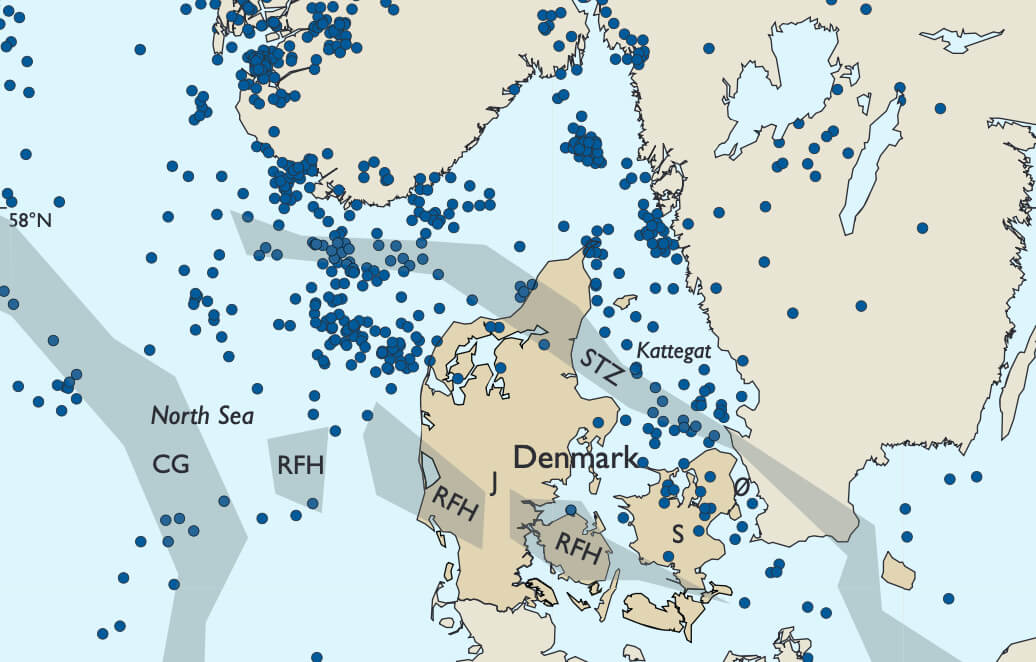
How to Cite
Share
Abstract
Recent Danish seismological projects involving neotectonic investigations and structural studies have determined the edge of the Baltic Shield underlying Denmark. The most active earthquake zones in Denmark are located in northwestern Jylland and adjoining offshore areas, and in the region around Kattegat, Øresund and north-east Sjælland (Fig. 1). This pattern was originally recognised by Lehmann (1956) and has been confirmed by several later studies, e.g. Gregersen et al. (1998). Recent, more detailed investigations have documented that changes in the pattern of earthquake activity have occurred within a short time span. The most pronounced example of change – possibly related to exploitation of hydrocarbons – is an activity recorded in the Central Graben area of the North Sea that was first documented by Gregersen et al. (1998). The south-western margin of the Precambrian Baltic Shield separates areas of different earthquake activity (Fig. 1; Gregersen et al. 1991). Although lithospheric stresses are more or less uniform in northern Europe, there are pronounced differences in the behaviour of the lithosphere across Denmark. The north-eastern area underlain by the Baltic Shield experiences brittle failure as recorded by common earthquakes, whereas earthquakes are virtually absent in the region southwest of the shield (Fig. 1). The margin of the Baltic Shield as defined by earthquake activity is not identical with that distinguished structurally in sedimentary studies (EUGENO-S Working Group 1988; Vejbæk & Britze 1994), in crustal studies (Abramovitz & Thybo 2000), or by recent studies of the structure of the subcrustal lithosphere (Gregersen et al. 2002; Shomali et al. 2002). The physical edge of the Baltic Shield cannot be uniquely determined on the basis of seismological studies. The earthquakes recorded, although of low magnitude, do give information about the released stresses. The earthquakes seem to be a response to a dominant NW–SE compression, also apparent elsewhere in Scandinavia and northern Europe (Slunga et al. 1984; Slunga 1989; Gregersen 1992; Müller et al. 1992). These stresses are part of the large-scale stress systems associated with continued plate motion pattern (Gregersen & Basham 1989; Zoback et al. 1989). In contrast to present low-magnitude earthquakes, postglacial sediments in northern Scandinavia have preserved features interpreted as caused by earthquakes of magnitudes around 7; these major, c. 9000 years old earthquakes are believed to be related to the post-glacial uplift of Scandinavia (e.g. Arvidsson et al. 1991; Gregersen 2002). Earthquakes are always related to fault activity, but attempts to link recent earthquakes occurring in and around Denmark to geologically known faults have only been partly successful (Gregersen et al. 1996). The most significant fault zone in Denmark, the Sorgenfrei–Tornquist Zone, is only locally active. Recent geodetic and seismic investigations demonstrate that the two sides of the Sorgenfrei–Tornquist Zone are characterised by different patterns of deformation, but the zone itself is not defined by a present-day seismicity trend crossing the central parts of Denmark (Fig. 1).
How to Cite
Share
Downloads
Editors: Martin Sønderholm & A.K. Higgins
The Review of Survey activities presents a selection of 18 papers reflecting the wide spectrum of activities of the Geological Survey of Denmark and Greenland, from the microbial to the plate tectonic level.
Activities in Denmark: The Survey's activities in Denmark are documented by 11 papers. The main themes [...]










